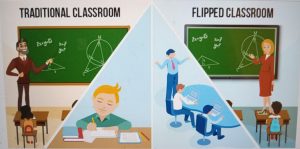
Mohanty, R. (2020, May 18). Traditional classroom vs. flipped classroom. Medium. https://medium.com/lecturenotes-in/traditional-classroom-vs-flipped-classroom 2e5c15acb4f2
The effectiveness of flipping education versus traditional education in hyperlinked academic libraries can depend on various factors, including the learning objectives, student preferences, and instructional strategies utilized. Here are some considerations comparing the effectiveness of these two approaches:
Flipping Education in Hyperlinked Academic Libraries:
- Active Engagement: Flipped education encourages student engagement through pre-class activities such as watching videos, reading materials, and completing online exercises. This can lead to a deeper understanding and retention of the material.
- Personalized Learning: Flipped classrooms allow students to work independently, revisit content as needed, and receive more individualized instruction and educator feedback.
- Collaborative Learning: Flipped education in hyperlinked academic libraries can promote collaboration, discussion, and peer-to-peer learning during in-person class sessions, enhancing student communication and teamwork skills.
- Access to Resources: Hyperlinked academic libraries provide students with easy access to a wide range of digital resources and research materials that can supplement and enhance the flipped learning experience.
Traditional Education in Hyperlinked Academic Libraries:
- Structured Learning Environment: Traditional education in hyperlinked academic libraries provides a structured learning environment with clear learning objectives, lectures, assignments, and assessments, which can benefit students who prefer a more traditional approach to learning.
- Immediate Feedback: In traditional classrooms, instructors can provide real-time feedback and clarification during lectures and class discussions, which may help students better understand complex concepts.
- Familiarity: Some students may be more comfortable with traditional instructional methods, such as in-person lectures and physical textbooks, rather than relying on online resources and videos for learning.
In conclusion, the effectiveness of flipping education versus traditional education in hyperlinked academic libraries ultimately depends on students’ and educators’ specific needs and preferences. Flipped education can promote active learning, collaboration, and personalized instruction, while traditional education provides structure, immediate feedback, and familiarity for some students. By incorporating best practices from both approaches and leveraging the resources available in hyperlinked academic libraries, educators can create a dynamic learning environment that meets students’ diverse needs and promotes effective learning outcomes.

What in the world? That tree/bench/bookcase is the coolest ever! My dad is a tree trimmer and loves books so I sent him a picture. I went to the link in the caption, but there wasn’t any information as to where one can find this masterpiece. Do you have any idea where this is located?
I have discovered the tree with books is on facebook. The email linked below the picture. I hope this was helpful.
Frances – A balanced and thoughtful exploration of changing academic libraries as settings for learning. Super cool image!
A sense of balance goes a long way; thank you!